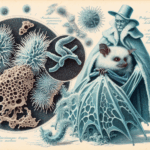252 million years ago, Earth decided to hit the reset button. The End-Permian extinction—also known as the Great Dying—wiped out 96% of marine species and turned the planet into something resembling a post-apocalyptic wasteland. Oceans turned toxic, temperatures skyrocketed, and life suffered a catastrophic collapse. But on land? Things weren’t quite as bleak.
New research from the Nanjing Institute of Geology and Paleontology (NIGPAS) suggests that, while the seas boiled and the atmosphere choked on volcanic exhalations, certain pockets of life thrived. Hidden oases—refugiums, as the scientists call them—offered a safe haven where plants, and the animals that depended on them, endured the chaos.
These sanctuaries weren’t just lucky accidents. They may have played a crucial role in rebuilding ecosystems that should have taken millions of years to recover. Instead, thanks to these biological life rafts, nature rebounded much faster than expected.
LIFE, UH, FINDS A WAY
In China’s Turpan-Hami Basin, researchers unearthed fossil evidence that paints a striking picture: tree trunks, ferns, and roots still embedded in what was once fertile soil. This wasn’t just a mass graveyard of plant debris swept in from elsewhere—these organisms actually lived here, grew here, and survived.
Pollen grains and spores trapped in stone revealed that these refugiums weren’t barren wastelands, but thriving ecosystems. The conditions were stable enough to support forests, which in turn sustained herbivores, predators, and whatever else was lucky enough to stumble into this prehistoric Eden.
Somehow, while much of the planet was baking under a toxic sky, these isolated patches remained livable—functioning as biological time capsules that carried life through Earth’s darkest chapter.
THE VOLCANIC APOCALYPSE THAT COULDN’T QUITE FINISH THE JOB
The End-Permian extinction was triggered by the Siberian Traps, a nightmarish volcanic event that spewed enough carbon dioxide and methane to make modern climate change look like a mild fever. Oceanic anoxia, acid rain, and global warming turned entire ecosystems into graveyards.
But even in this hellscape, refugiums persisted. Exactly why remains a mystery, but local geography, climate quirks, or underground water sources might have shielded them from the worst of the catastrophe. The plants not only survived—they thrived, forming the backbone of future ecosystems.
And that’s the real kicker: without these stubborn patches of life, the rise of the Mesozoic era—home to the dinosaurs—might have been delayed or derailed entirely. Evolution doesn’t take kindly to total annihilation. It just reroutes.
THE LAST LAUGH BELONGS TO PLANTS
While most species were signing their extinction papers, plants in these refugiums were busy carrying on like nothing had happened. In fact, some of the survivors likely gave rise to the dominant flora of the Mesozoic.
So while the oceans stewed in their own toxicity, and land elsewhere became a barren wasteland, these pockets of greenery kept the biosphere’s engine humming. Life, it turns out, is annoyingly difficult to erase. Even on a planet that’s trying its best.
Did You Know?
- The End-Permian extinction was so severe that Earth’s recovery took at least 10 million years—unless you were lucky enough to live in a refugium.
- Some scientists suspect that the runaway greenhouse effect during this time made parts of the planet as hot as modern-day ovens—literally.
- If you think modern pollution is bad, the Siberian Traps eruptions released 3 million cubic kilometers of lava and enough carbon to rewrite Earth’s climate for millennia.





